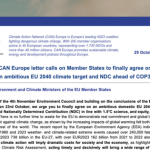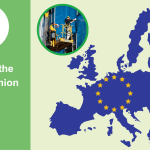On June 30, Member States have to submit the final revision of their National Energy and Climate Plans (NECPs) to the European Commission. This deadline risks being neglected by the public discourse, as it falls in the aftermath of the EU elections and at a time when the buzz around them remains loud. It would be a mistake: this is one of the moments of truth for Europe’s commitment to climate action. Here’s why.
This article was first published in Energy Post on 21/06/2024.
NECPs constitute an indispensable link between EU and national policy-making, the one place where national climate and energy planning comes together – that is, where Member States can fully showcase their plans for bold climate action and a socially just transition. Specifically, all Member States are required to describe, based on a common template, their climate and energy targets and trajectories until 2030, with an outlook to 2040 and the longer term. NECPs must also feature the policies and measures planned to achieve these targets, as well as their funding needs and sources. First adopted in 2019, they are now being revised – a process of great importance given the context in which it takes place.
Concrete commitments in the misty aftermath of the EU elections
As a result of the EU elections we will have a new European Parliament, a new Commission, even some reshuffling of national governments, new political alliances, new strategic priorities, new legislative proposals that will shape our future. New has its charm. But in the uncertain mist of promises and political bargaining that will surround the next months, it is in their final NECPs that Member States will have to show how much they remain truly committed to leading the way towards ambitious climate action and a socially just transition. Concretely, with targets, plans and measures, and immediately, before any hands are shaken at the EU level or a weakening compromise is found.
After all, there is no need to wait. Parliamentary seats may have changed and new Commissioners will be appointed, but our planet and its ecological and social challenges have remained the same. So have the priorities of European citizens. The vote was characterised by frustration at the rising cost of living and growing inequalities, but climate remains in the top three areas where citizens call the European Union to take action in the next 5 years. Achieving the 1.5°C goal of the Paris Agreement and ensuring a socially just transition: that’s what citizens are asking for. We know that the two go hand in hand, and that a climate-proof energy transition has concrete benefits for energy independence, health, and cost of living. According to recent research conducted by CAN Europe, aligning with a 1.5°C trajectory by stepping up 2030 climate ambition would yield economic benefits of at least €1 trillion by 2030. At a time of uncertainty and political promises, delivering ambitious NECPs would be a concrete demonstration that Member States hear their citizens’ concerns, and are ready to act on them. The sobering reality is that – as shown below – the plans are alarmingly inadequate to lead the needed transformation and Europe is possibly heading for a failure.
Reaching 2030 targets and reinforcing the credibility of the Green Deal
The newly formed European Parliament and the upcoming Commission will play a crucial role in defining our pathway towards climate neutrality. The task is not easy, but still within reach: to keep the 1.5°C limit alive and avoid the worst consequences of the climate crisis – the EU must achieve net-zero emissions by 2040 at the latest. But to achieve climate neutrality, we first need to get to 2030 in the right shape. The European Union has set a target of -55% net emissions compared to 1990, while its fair and science-based share would be -76% net emissions. In any case, an unprecedented level of climate action is required in the next few years.
While most of the 2030 targets are already enshrined in the Green Deal legislation, it is in the final revised NECPs that we will truly be able to see whether Member States have a serious plan to turn them into tangible action, and ultimately whether the EU will meet them. Member States have the chance to demonstrate that the implementation of the Green Deal is well underway, but also that the possibility exists to go beyond its level of ambition and closer to our Paris Agreement commitments. Ambitious and well-planned NECPs would also be a strong signal for the Union’s credibility as a climate champion at the international level, and they will determine whether the new EU 2035 Nationally Determined Contribution (NDC) reflects the highest possible ambition, as per Article 4.3 of the Paris Agreement.
Final revised NECPs need to be much better than the drafts
None of the above will materialise unless the final revised NECPs are significantly better than the drafts Member States submitted in 2023. In its assessment of the drafts, dated December 2023, the European Commission has stated that “Member States must increase their ambition and implement significant improvements before the submission of their final updated NECPs in June 2024”, echoing the concerns raised by NGOs and soon confirmed by the first progress report of the European Scientific Advisory Board on Climate Change’s (ESABCC).
According to the European Commission, the drafts – assuming all that is promised on paper will materialise – would only deliver -51% net greenhouse gas emissions reduction, which is not in line with the EU 2030 targets (-55%) and well below what would be required to align with the Paris Agreement. And it’s not just about the ambition gap. The drafts must improve in the quality and quantity of policies and measures, the evaluation of their impacts, the allocation of funding, the phaseout of fossil fuels and fossil fuel subsidies. And of course, in the integration of the social dimension into their climate and energy policies, to prevent adverse impacts on the most vulnerable.
As the deadline approaches…
Member States are supposed to submit their final revised plans by 30 June. However, it is unlikely that many will respect the deadline. In 2023, only eight Member States submitted their drafts on time, while a majority was submitted in the Autumn, between September and December (as of today, Austria’s draft is the only one still missing). According to the latest available information, even for final plans only a handful of countries – which should include Denmark, Italy and Spain – are expected to submit on time, though the context can evolve quickly. What is certain is that this deadline should not pass unheard. In the uncertain post-election context, and in turbulent times, the final revised NECPs will clearly signal whether Europe will meet its 2030 climate and energy ambition, and where it might go next. It is about showing citizens the countries’ concrete commitment to climate action and a socially just transition, and about Europe’s credibility in the global fight against the climate crisis.
Backround
NECPs were first adopted in 2019 and – as required by the Governance Regulation – were set to be revised between 2023 and 2024. Draft revisions were expected in June 2023, while the final versions must be delivered by the end of this month. The ongoing revision of NECPs is of great importance because the policy landscape has evolved substantially since their first version. To name a few policy packages that were introduced after 2019: ‘Next Generation EU’, ‘REPowerEU’, the entire European Green Deal and the related ‘Fit for 55’ package. The Effort Sharing Regulation, the LULUCF Regulation, the Renewable Energy Directive and the Energy Efficiency Directive, which set the targets and contributions to which Member States must refer in their NECPs, have all been revised.
Author
FEDERICO MASCOLO, TOGETHER FOR 1.5 PROJECT POLICY COORDINATOR



